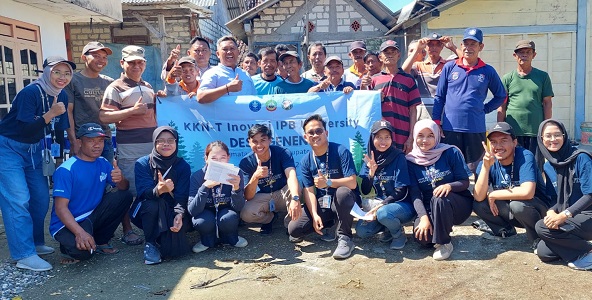IPB University Innovation Real-Thematic Work Lecturer Students Create Training on Making Alternative Animal Feed and POC in Geneng Village, Blora

As an effort to deal with problems in Geneng Village, Jepon, Blora District, Central Java, IPB University students in the Thematic Real Work Lecture (KKN-T) Innovation program provide animal feed training from elephant grass and rice straw, as well as making liquid organic fertilizer (POC) from cow dung.
In Geneng Hamlet, IPB University students make alternative feed for silage livestock. Silage is animal feed fermented with the main ingredient elephant grass, or what the people of Geneng Village call 'kolonjono'.
"The benefits of silage are not only as a substitute for feed but also as additional nutrition for livestock. This silage needs to be added EM4 and molasses to help the fermentation process from elephant grass. The silage process takes 14 days with the anaerobic method," said Mulianajillaniatus Sofi'ah, one of the students of Innovation Real-Thematic Work Lecturer.
Previously, IPB University Innovation Real-Thematic Work Lecturer students carried out POC training in Kemloko Hamlet, Geneng Village. The purpose of this training is to utilize dried livestock manure to be used as POC. Besides being able to be used for fertilizer, POC can also be used as an insecticide to eliminate insects and protect plants from pests. The proceeds from this POC will be distributed to the people present.
"Not only that, we also held training on making alternative animal feed from ammonia or rice straw piles in Tanjung Hamlet, precisely at the RW 02 Sarasehan Post. Ammonia is a method of chemical processing feed. The feed ingredients are fermented for 21 days without using chemicals," added Sofi'ah.
She further added that the materials needed to make ammonia include a dummy or rice straw, urea, water, and empty barrels. The process of such fermentation must be anaerobic. "Urea is used as much as two percent because if there is too much urea, then the livestock will be poisoned," she explained.
These activities were attended by hamlet heads, village heads, and ranks as well as dozens of people who participated enthusiastically. In fact, based on information from the chairman of RW 02, Tanjung Hamlet, Ngadi stated, "Actually, we became national champions in animal feed competitions in the 80s."
IPB University Innovation Real-Thematic Work Lecturer students also conduct monitoring, distribute brochures for manufacturing instructions to help farmers and ranchers, and check the final results of POC, silage, and ammonia. It is hoped that this training can help the surrounding community provide feed ingredients during the dry season. (*/Rz) (IAAS/MZS)



